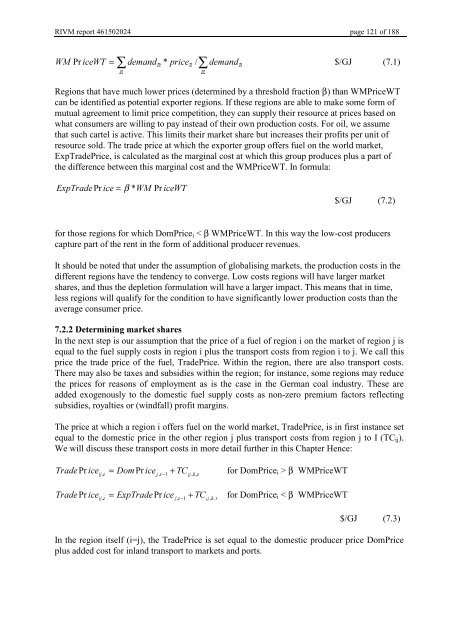Targets IMage Energy Regional (TIMER) Model, Technical ...
Targets IMage Energy Regional (TIMER) Model, Technical ...
Targets IMage Energy Regional (TIMER) Model, Technical ...
Create successful ePaper yourself
Turn your PDF publications into a flip-book with our unique Google optimized e-Paper software.
RIVM report 461502024 page 121 of 188<br />
:0 Pr LFH:7 = ∑ GHPDQG * SULFH /<br />
5 5 ∑ GHPDQG<br />
$/GJ (7.1)<br />
5<br />
5<br />
5<br />
Regions that have much lower prices (determined by a threshold fraction β) than WMPriceWT<br />
can be identified as potential exporter regions. If these regions are able to make some form of<br />
mutual agreement to limit price competition, they can supply their resource at prices based on<br />
what consumers are willing to pay instead of their own production costs. For oil, we assume<br />
that such cartel is active. This limits their market share but increases their profits per unit of<br />
resource sold. The trade price at which the exporter group offers fuel on the world market,<br />
ExpTradePrice, is calculated as the marginal cost at which this group produces plus a part of<br />
the difference between this marginal cost and the WMPriceWT. In formula:<br />
([S7UDGH Pr LFH = β *:0<br />
Pr LFH:7<br />
$/GJ (7.2)<br />
for those regions for which DomPrice i < β WMPriceWT. In this way the low-cost producers<br />
capture part of the rent in the form of additional producer revenues.<br />
It should be noted that under the assumption of globalising markets, the production costs in the<br />
different regions have the tendency to converge. Low costs regions will have larger market<br />
shares, and thus the depletion formulation will have a larger impact. This means that in time,<br />
less regions will qualify for the condition to have significantly lower production costs than the<br />
average consumer price.<br />
'HWHUPLQLQJPDUNHWVKDUHV<br />
In the next step is our assumption that the price of a fuel of region i on the market of region j is<br />
equal to the fuel supply costs in region i plus the transport costs from region i to j. We call this<br />
price the trade price of the fuel, TradePrice. Within the region, there are also transport costs.<br />
There may also be taxes and subsidies within the region; for instance, some regions may reduce<br />
the prices for reasons of employment as is the case in the German coal industry. These are<br />
added exogenously to the domestic fuel supply costs as non-zero premium factors reflecting<br />
subsidies, royalties or (windfall) profit margins.<br />
The price at which a region i offers fuel on the world market, TradePrice, is in first instance set<br />
equal to the domestic price in the other region j plus transport costs from region j to I (TC ij ).<br />
We will discuss these transport costs in more detail further in this Chapter Hence:<br />
7UDGH Pr LFHLM, W<br />
'RP Pr LFH<br />
M,<br />
W 1<br />
+ 7&<br />
LM,<br />
N,<br />
=<br />
−<br />
for DomPrice i > β WMPriceWT<br />
W<br />
7UDGH Pr LFHLM, W<br />
= ([S7UDGHPr<br />
LFH<br />
M,<br />
W−1<br />
+ 7&<br />
LM,<br />
N,<br />
W<br />
for DomPrice i < β WMPriceWT<br />
$/GJ (7.3)<br />
In the region itself (i=j), the TradePrice is set equal to the domestic producer price DomPrice<br />
plus added cost for inland transport to markets and ports.
















